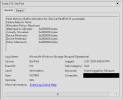Does HWInfo currently report back any information on SSD utilization of a Host Memory Buffer (HMB)? If not, could that be a feature to add? As I understand it a HMB is used by some DRAM-less SSD drives to take the place of the on-drive DRAM buffers used for address mapping tables and are usually fairly small, under 100MB.
At first I assumed the Crucial P3 Plus NVME SSD drive I recently installed set up its HMB with the Windows default NVME drivers. But when I found and installed an NVME driver from Micron's (Crucial's parent company) support site along with it's control panel (Storage Executive) I discovered I had to enable it's HMB features. It would be good to know from an independent and reliable system-level utility like HWInfo64 that it's being utilized.
At first I assumed the Crucial P3 Plus NVME SSD drive I recently installed set up its HMB with the Windows default NVME drivers. But when I found and installed an NVME driver from Micron's (Crucial's parent company) support site along with it's control panel (Storage Executive) I discovered I had to enable it's HMB features. It would be good to know from an independent and reliable system-level utility like HWInfo64 that it's being utilized.
Last edited:

